Header Image from National Park Service Grand Canyon National Park, Arizona.
Arizona; Date Admitted: Feb 14, 1912 as the 48th state.
Arizona was the last of the 48 contiguous United States to be admitted to the union. President William Howard Taft wanted to make Arizona a state on 12th February. Since it was Lincoln’s birthday and the next day 13th, is considered as an unlucky number; so, on the following day, that is 14th February or the Valentine’s Day, Arizona joined the union and became America’s Valentine.
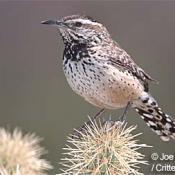 Bird: Cactus Wren. – The cactus wren grows seven to eight inches long and likes to build nests in the protection of thorny desert plants like the arms of the giant saguaro cactus.
Bird: Cactus Wren. – The cactus wren grows seven to eight inches long and likes to build nests in the protection of thorny desert plants like the arms of the giant saguaro cactus.
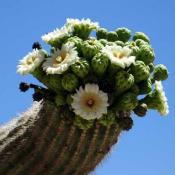 Flower: Saguaro Cactus Blossom –
Flower: Saguaro Cactus Blossom –
The Saguaro Cactus can reach more than 50 feet tall and live more than 200 years. It can take up to 100 years for a Saguaro cactus to grow an arm in areas of low precipitation. Arizona’s Sonoran Desert is the only place on earth where the iconic saguaro cactus grows.
The white flower blooms on the tips of the saguaro cactus during May and June. It blooms in the middle of the night and closes the next day—surviving only about 18 hours for pollination by nocturnal animals like bats and moths. The saguaro is the largest American cactus. If you cut down an endangered cactus like the Saguaro in Arizona, you could face up to a year in prison.
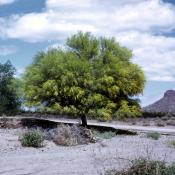 Tree: Paloverde – The Palo verde is the official state tree. Its name means green stick and it blooms a brilliant yellow-gold in April or May.
Tree: Paloverde – The Palo verde is the official state tree. Its name means green stick and it blooms a brilliant yellow-gold in April or May.
State Quarter
From theus50.com
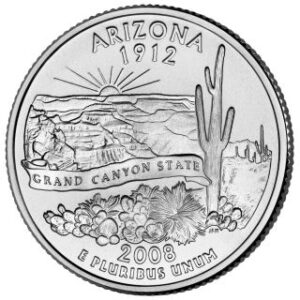
Arizona was admitted into the Union on February 14, 1912, becoming our Nation’s 48th state, and the last in the continental United States.
The Arizona quarter features an image of the Grand Canyon with a Saguaro cactus in the foreground. A banner reading “Grand Canyon State” separates the two images to signify that the Saguaro cactus does not grow in the Grand Canyon. The coin also bears the inscriptions “Arizona” and “1912.”
One of the seven natural wonders of the world, the Grand Canyon covers more than 1.2 million acres in northwestern Arizona. The Canyon, sculpted by the mighty Colorado River, is 6,000 feet deep at its deepest point and 18 miles at its widest. It is home to numerous rare and threatened plant and animal species. The Grand Canyon joined the National Park system in 1919 and is visited by more than four million tourists a year.
Capital: Phoenix
Nickname: Grand Canyon State
Motto: God enriches
Petrified wood is the official state fossil. Most petrified wood comes from the Petrified Forest in northeastern Arizona.
Turquoise is the official state gemstone. The blue-green stone has a somewhat waxy surface and can be found throughout the state.
Arizona Facts and Trivia
Arizona is the 6th largest state at 113,990 square miles; its dimensions are 400 miles N-S and 310 miles W-E.
Originally part of New Mexico, the land was ceded to the United States in 1848, and became a separate territory in 1863.
There are two sides in the argument over the origin of Arizona’s name. One side says that the name comes from the Basque aritz onak (“good oak”) and was applied to the territory because the oak trees reminded the Basque settlers in the area of their homeland.
The other side says that the name comes from the Spanish Arizonac, which was derived from the O’odham (the language of the native Pima people) word ali ?ona-g (“having a little spring”), which might refer to actual springs or a site near rich veins of silver discovered in 1736.
Arizona boasts 107 species of native reptiles — 49 lizards, six turtles and 52 snakes.
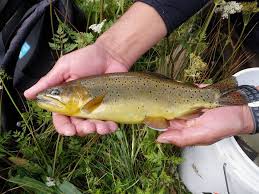 The Arizona trout, also called Apache trout, is found only in Arizona.
The Arizona trout, also called Apache trout, is found only in Arizona.
Copper was discovered in 1854, and copper mining was Arizona’s premier industry until the 1950s.
Arizona leads the nation in copper production. The amount of copper on the roof of the Capitol building is equivalent to 4,800,000 pennies. Bisbee, located in Tombstone Canyon, is known as the Queen of the Copper Mines. During its mining history the town was the largest city between Saint Louis and San Francisco.
Once a rowdy copper mining town, Jerome’s population dwindled to as few as 50 people after the mines closed in 1953.
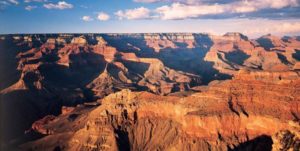
The Grand Canyon
Arizona is home of the Grand Canyon National Park. 55 people have accidentally fallen to their deaths from the rim of the Canyon. There aren’t any dinosaur fossils at the Grand Canyon because the rocks are way older than the dinosaurs.
Formed by the Colorado River over a period of 3 to 6 million years, Arizona’s Grand Canyon is 277 miles long, up to 18 miles wide and one mile deep. Nearly 5 million people visit Grand Canyon National Park each year.
Arizona observes Mountain Standard Time on a year round basis. The one exception is the Navajo Nation, located in the northeast corner of the state, which observes the daylight savings time change. The capital of the Navajo Reservation is Window Rock.
After the Mexican-American War, the United States gained control of much of the southwest including Arizona. They purchased the land for $15 million as part of the Treaty of Guadalupe Hidalgo, which was signed in 1848. Additional land was added in southern Arizona in 1853 through the Gadsden Purchase.
Most historians agree that the westernmost Civil War battle took place in 1862 at Picacho Pass, 50 miles northwest of Tucson. At the start of the Civil War, Arizona was part of the Territory of New Mexico. When the war began, Arizona separated from the United States and joined the Confederacy. Arizona sent men and supplies to support the Confederate states. The westernmost battle of the Civil War was fought at the Battle of Picacho Pass between Union soldiers from California and Confederate soldiers from Tucson, Arizona.
Phoenix originated in 1866 as a hay camp to supply Camp McDowell.
The legendary 1881 Gunfight at the O.K. Corral in the Arizona Territory town of Tombstone is considered the most famous shootout in the American Old West.
Arizona was admitted Feb 14, 1912 as the 48th state.
The battleship USS Arizona was named in honor of the state. It was commissioned in 1913 and launched in 1915 from the Brooklyn Navy Yard.
In 1926, the Southern Pacific Railroad connected Arizona with the eastern states.
Navajo Indians from Arizona were enlisted to transmit secret communications for the U.S. Marines after the Japanese bombed Pearl Harbor in 1941. Known as Navajo Code Talkers, these young men created an oral code the enemy was unable to decipher, fulfilling a crucial role during World War II and saving countless lives.
In 1956, two planes detoured over the Grand Canyon’s airspace for a better view and ended up colliding directly over the canyon. The FAA was created in 1958 as a result.
Morton Salt has been mining a salt deposit in unincorporated Glendale since the mid-1980s that is about 40 square miles wide and more than half a mile thick.
The state’s most popular natural wonders include the Grand Canyon, Havasu Canyon, Grand Canyon Caves, Lake Powell/Rainbow Bridge, Petrified Forest/Painted Desert, Monument Valley, Sunset Crater, Meteor Crater, Sedona Oak Creek Canyon, Salt River Canyon, Superstition Mountains, Picacho Peak State Park, Saguaro National Park, Chiricahua National Monument, and the Colorado River.
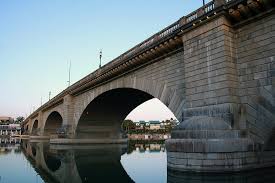 The original London Bridge was shipped stone-by-stone and reconstructed in Lake Havasu City.
The original London Bridge was shipped stone-by-stone and reconstructed in Lake Havasu City.
The state’s precipitation varies. At Flagstaff the annual average is 18.31 inches; Phoenix averages 7.64 inches; and Yuma’s annual average is 3.27 inches.
Four Corners is noted as the spot in the United States where a person can stand in four states at the same time – Arizona, New Mexico, Utah, and Colorado.
Arizona has the largest percentage of land designated as Indian lands, and 21 federally recognized American Indian tribes.
Arizona has 13 species of rattlesnakes, more than any other state. About 150 people are bitten by rattlesnakes every year in Arizona.
The best preserved meteor crater in the world is in Winslow, Arizona.
Although Arizona is the sixth largest state in area, only about 17 percent of it is privately owned. The rest goes to public forest and park lands, state trust lands, and Native American reservations.
Every American president since Herbert Hoover has stayed at the Arizona Biltmore Resort and Spa in Phoenix, except for President Obama and President Trump.
Possibly Arizona’s most famous criminal, Ernesto Miranda, is the man responsible for mandated Miranda laws. – “You have the right to remain silent…”
The sun shines in Phoenix and Tucson 85 percent of the year, even more than Florida and Hawaii.
Rising to a height of 12,643 feet, Mount Humphreys north of Flagstaff is the state’s highest mountain.
At one time camels were used to transport goods across Arizona.
The most difficult to pronounce town name in Arizona is Sonoita: From rd.com: Here’s a prime example of the problem Americans face when they find it challenging to pronounce the names of cities and towns that have origins in other languages. From the looks of it, Sonoita, Arizona would appear to originate from the Spanish language (which in fact, is true), which might lead you to pronounce it as So-no-EE-ta]. Nope. The locals pronounce it as Suh-NOY-ta.
In Presidential Politics: Arizona has voted for the Republican presidential candidate in every election since 1968 with the exception of Bill Clinton in 1996. In 2016 Donald Trump carried the state by 48% to Clinton’s 44.5%.
Weird Laws
Arizona is a right-to-work state. The law states no person shall be denied the opportunity to obtain or retain employment because of non-membership in a labor organization.
Donkeys are not allowed to sleep in bathtubs.
It’s illegal to refuse a person a glass of water.
Performing fortunetelling, palm reading or palmistry in exchange for compensation is considered a misdemeanor in Avondale, and it is illegal to practice hypnotism or to be hypnotized, even if it’s free.
It is illegal to sell tobacco cigarettes, cigars, snuff and chewing and dipping tobacco from a vending machine in Buckeye,
In El Mirage it’s a misdemeanor punishable by a fine of at least $350 to use a clothesline anywhere other than on a residential property behind a wall that completely conceals it from view on the street.
Music:
I Love You Arizona by Rex Allen, Jr. (Official State Song)
“Route 66” Nat King Cole
“By the Time I Get to Phoenix” by Glen Campbell
“Take It Easy,” by the Eagles
People:
-
- Rex Allen singer, actor
- Lynda Carter actress
- Cesar Estrada Chavez labor leader
- Cochise, Apache Indian chief
- Rosemary DeCamp, actress
- Andy Devine, actor
-
 Barbara Eden, actress “I Dream of Jeannie”
Barbara Eden, actress “I Dream of Jeannie”
-
- Geronimo, Apache Indian Chief
-
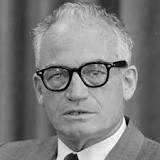 Barry Goldwater politician
Barry Goldwater politician
- Linda Ronstadt singer
Credits:
See AZ central.com
See Oh Facts.com
See Ducksters.com
See Mental Floss.com
See History.com
See 50 states.com
See Movoto.com
See Tidbits of History.com/states for facts and trivia about each of the states.

Pingback: This day in history, February 14